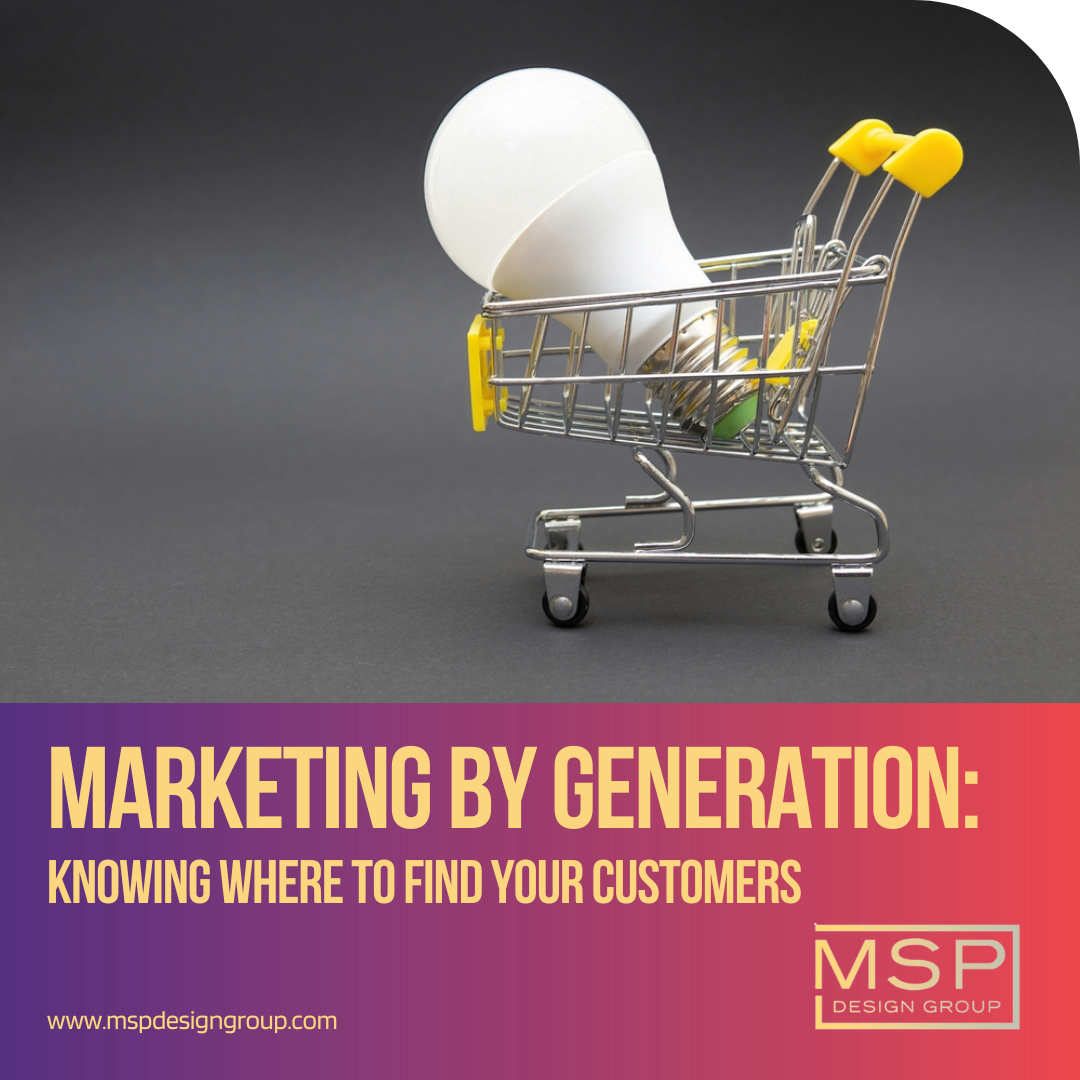
Generational marketing came to the forefront of marketing when it became apparent different age groups reacted differently to different platforms. These groups are not only divided by age, but the type of social media they most engage with. Finding the correct social media on which to market to each generation is likely to yield better results.
To make the most of these channels, it’s important to know what those platforms are, and which ones are used by whichever age group you’re trying to reach.
What is Marketing by Generation?
Marketing by generation tailors marketing efforts to specific generational cohorts, such as Baby Boomers, Generation X, Millennials, and Generation Z. The benefit of marketing by generation is that it allows marketers to create more effective and targeted campaigns that resonate with the unique needs, values, and preferences of each generation. Here are some specific benefits:
- Increased relevance: By targeting marketing efforts to specific generations, marketers can create messaging that is more relevant and relatable to their target audience. This can help build trust and credibility with potential customers, increasing the likelihood that they will engage with the brand.
- Improved engagement: By understanding the unique communication styles, preferences, and behaviors of each generation, marketers can create campaigns that are more likely to capture their attention and elicit a response. This can help increase engagement with the brand, such as website visits, social media interactions, and sales.
- Higher conversion rates: By tailoring marketing efforts to specific generations, marketers can create campaigns that are more likely to convert potential customers into paying customers. This is because campaigns that resonate with a target audience are more likely to result in leads, inquiries, and sales.
- Greater loyalty: By creating campaigns that speak to the unique needs, values, and preferences of a specific generation, marketers can build deeper connections with their audience. This can lead to greater loyalty and advocacy, as customers feel that the brand truly understands and cares about their needs.
In summary, marketing by generation allows marketers to create more targeted and effective campaigns that resonate with their audience, leading to increased engagement, conversions, and loyalty.
How Do I know Who is in Each Marketing Generation?
For simplicity’s sake, let’s define the groups you’re targeting and their annual spending habits:
Gen Z (ages 18-24) $44 billion
Millennials (ages 25-35) $322.5 billion
Gen X (ages 35-54) $357 billion
Boomers (ages 55 and up) $548.1 billion
How Do I Know Where Each Marketing Generation Shops?
This may surprise you, but apart from millennials, who shop equally online and in-store, all the generations prefer to shop in-store. The older generations are more accustomed to the shopping experience and the ease of returns that goes with buying in-store.
Gen Z shops in-store for the speed of purchasing something as well as the social experience of shopping with friends.
A whopping 65% of millennials shop Amazon (although all generations listed shop online) for its shipping convenience, while twice as many Gen Z shoppers are more likely to use an online-only store brand than the other generations.
Different lifestyles, spending habits, and the amount of disposable income, makes a one-size-fits-all approach to marketing almost impossible, so let’s take a look at the different ways you can target each demographic.
What digital platforms are going to reach Gen-Z?
According to an article in HubSpot, the 18-24 generation is most likely to discover new products through internet searches and social media, such as Instagram, Tik Tok, and YouTube. It’s worth noting that 91% of Gen Zer’s spend an average of 4 hours plus online daily.
One-third of Gen-Zer’s have bought a product based on an influencer’s recommendation, while a little more than one quarter have made a purchase through an in-app shop. One top influencer posted an exclusive discount code for a product on her site, which not only encouraged her followers to purchase the product, but to do so while the discount code still applied.
Half of Gen Zer’s are more likely to reward companies with their loyalty if they support social causes, such as racial and gender equality, LGBTQ+ rights, climate change, and sustainability. Because of this, they may trust your brand more if you offer them the most up-to-date and transparent information on your product.3
Perhaps not surprisingly, ads on streaming services are more likely to influence Gen Z’s buying habits than an ad on cable channels. They also prefer short-form videos about new products, according to the HubSpot article.
Which digital platforms help you reach Millennials?
The 25-35 crowd isn’t that different than the Gen Z demographic, in that they also get their information concerning new products from internet searches, Facebook, Instagram and YouTube being the top social platforms they frequent. Millennial women are more likely to get their information from Facebook, followed by the other platforms, whereas Millennial men tend to get their facts from YouTube.
Still close to Gen Z’s percentage, 28% of Millennials buy product through an in-app store, while 26% take their cue from an influencer’s recommendation.
Slightly less than half of Millennials (41%) want companies involved in the same social causes as Gen Zer’s do (racial and gender equality, LGBTQ+ awareness, and climate changes.
There is only a slight difference in Millennials being more likely to have their buying habits influences by ads on cable channels over those on streaming.
Where Do Boomers and Gen X do their research and shopping?
Unlike the previous two age groups, Gen X prefers to discover new items through television ads, searches, and in-store shopping.
Although it’s not their preferred source of product information, 90% of Gen Xers make their discoveries on social media, such as Facebook, YouTube, and Instagram.
Only 18% of Gen Xers use an in-app shop, while the same number have bought something based on an influencer’s recommendation. They are also more inclined to do most of their online shopping on their smart phones.
Gen X also wants the companies they support to be involved in social causes, but the numbers — and the causes — differ: 35% want the companies to take a stance on climate change and racial justice but want to address things like affordable healthcare and income inequality.
38% would prefer business to stay out of social causes, while another 26% don’t know.
Compare this to nearly half of boomers wanting companies to stay out of social issues, saying it has no impact on their buying decisions.
TV ads, internet searches, and in-store shopping are the main ways boomers discover new products, while social media has no real influence on them. 5 In fact, 62% of boomers usually discover a new product through TV commercials, but 38% have found new items just by shopping in-store.
Can you use product discovery patterns to drive sales?
Of course. Know that you know where and how they shop, you can use their product discovery patterns to get your brand in front of the right target audience.
In online marketing, you want to create something that stands out from all the rest, and that means quality content. Even so, that’s only half the battle. You’ll also need to utilize the form of communication specific to each target group.
In the case of Millennials, you’ll want to reach them through their cell phones. Sound crazy? Not when you realize 91% of Millennials text, and they’re likely to purchase a product based on posts by the actual users. More importantly, they’re going to let the manufacturer know whether they like his product by using #hashtags. This also helps boost the product’s signal.
Generation X is more likely to respond to direct emails, with 68% of them saying they use coupons included in the email when they purchase an item.
Baby boomers still favor the old tried-and-true methods of product discovery, ranging from telemarketers to face-to-face interaction. You should also be aware that, though they’re active on Facebook, their social media time is probably less than an hour daily, and boomers are likely to report your online ad as spam if it pops up in their feed.
No matter who you’re targeting, knowledge is the key. Each age group responds to different forms of communication and product discovery, so knowing how and where they shop can maximize your sales. With a little effort and research, you can make sure your brand is front-and-center when it comes time for them to make their purchase.




